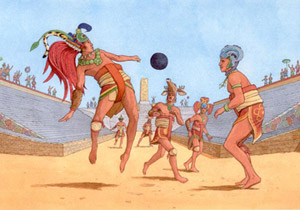Ancient Sports: Mesoamerican Ballgame
Sports have been a common practice amongst humans for thousand of years. The oldest form of sports were probably what we now call martial arts, although this could be questioned because the objective of these early practices were not competition itself but to prepare for real hand to hand combat situations.

The first well documented team competitive sport is Polo. It was first played in India mostly by emperors and their courtiers and documents about it date back to 3000 BC. Polo is still widely played today - considered an active sport in 77 countries and played professionally in 15. It was also originally conceived as a "war game" since it served as training for cavalry units. The basics of the game have been maintained to the present day although it was played at a much faster pace on the early days.
In this article we are going to cover a very interesting sport that most people never heard about...
Mesoamerican Ballgame | "Juego de Pelota" - Spanish, "ullamaliztli" - Nahuatl
Sport originated: earlier than 1400 BCE
This sport was played in Meso-american pre-Hispanic civilizations - from central Mexico to Honduras and Nicaragua. As most sports, the exact rules varied over time and place, but the basics of the game consisted in striking a rubber ball about the size of a volleyball with the hips - sometimes elbows were used also- and keeping it in play within a stone court. The 'outfit' consisted basically on a loincloth and a leather hip guard. The stone ball courts varied considerably in size but always remained the basic same width / length ratio - 4 to 1- and ![]() shape.
shape.
This was considered more than just an entertaining sport as it was soaked with the strong religious nature of meso-american civilizations. It represented a rivalry between cosmic forces and was closely related to warfare. Even. human sacrifices were involved in the game on a later stage of history. But at the same time, the social mechanics resembled those of modern sports: kids played it in school and in time, those who showed real talent were able to play it professionally. Games were held in places with large public attendances and also large-scale betting took place.
One of the game later variants added stone rings vertically placed on each side of the court at about 6 meters of the ground. If one visits such courts you begin to think how hard it would be to pass a rubber ball trough a 19 feet tall ring with a hole barely larger than the ball... while hitting it with your hips! However, on the sixteenth-century, Spaniards witnessed this Aztec variation of the game and said that placing the ball through the ring was a rare event. These Spaniards witnessed that points were lost by a player who let the ball bounce more than twice before returning it to the other team, who let the ball go outside the boundaries of the court, or who tried and failed to pass the ball through one of the stone rings, while the decisive victory was for the team that put the ball through a ring.
In modern days, a variation of this game is still played in meso-americans cultures. It is now called "Ulama" and while they still hit the ball with their hips the rules resemble to a net-less volleyball. Below you can see a video of a match being played in a Mexican comunity.




